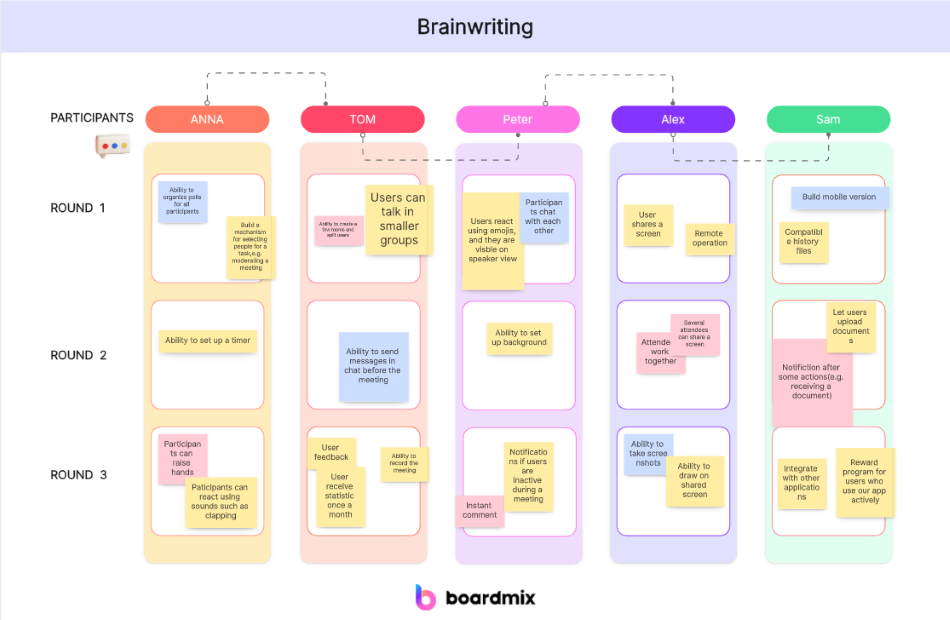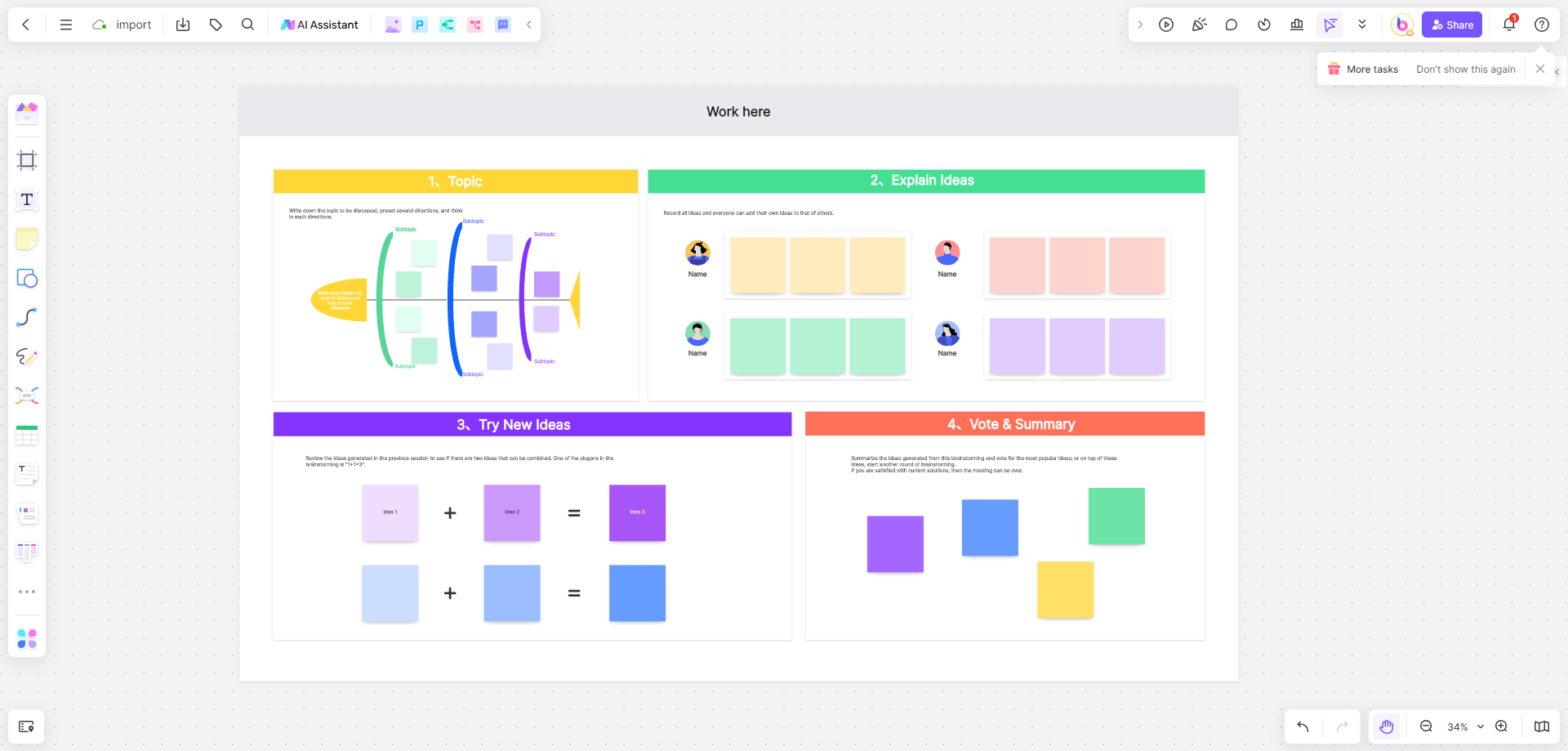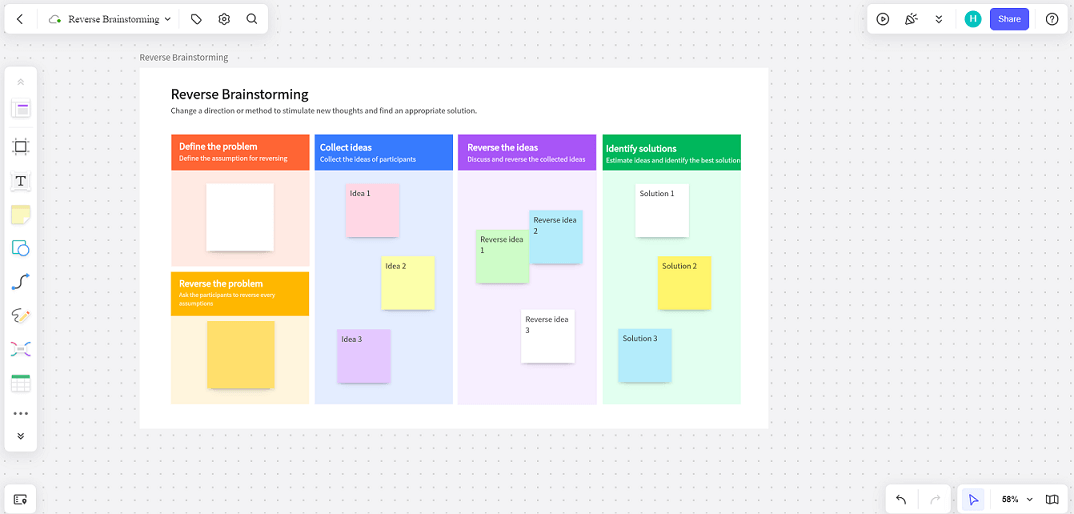When a team engages in effective brainstorming, miracles can happen. This method can effectively generate and gather diverse creative ideas. However, if there isn't an effective framework and method in place before starting the brainstorming process, you might end up with more problems than solutions after the meeting.
This article uses a team project as an example to summarize how to use brainstorming to complete user personas and which brainstorming questions can help us conduct brainstorming more efficiently. Let's take a look!

35 Essential Brainstorming Questions
A stimulating question can spark lively discussions and unexpected solutions. These questions encourage free thinking and creativity, helping the team solve current problems and engage in dynamic solution-building as a team.

Case Background:
The team is developing an educational robot aimed at promoting programming education in schools. To help team members understand users better and develop empathy, as well as to align everyone’s understanding of the product and users, a user persona brainstorming session was organized.
Firstly, it's important to create an environment where team members feel willing to contribute as a team and solve problems. This is a space that encourages the team to keep an open mind without judging any ideas presented. At this early stage, brainstorming is about both quality and quantity; good brainstorming is a method of gathering as many ideas as possible and expanding on them later. Therefore, we can prepare the following 35 brainstorming questions in advance.
(1) Introductory Questions:
What goals do we hope to achieve today?
What are the overall goals of this project?
What useful insights do we have in terms of information, numbers, or data?
What additional data or resources do we need to address this challenge?
What excites us about this project?
What do we see as the biggest challenge in this project?
(2) Information Gathering Questions:
How will our team operate?
What is our reporting method?
What skills are needed to achieve our goals?
What obstacles might we encounter in this project?
How will we collect user information?
How will we track our progress?
How and when will we ensure our deliverables are met?
(3) Discussion Encouraging Questions:
What are your initial impressions of this project?
How would you briefly summarize or pitch this project?
Can you explain the obstacles faced by this project in simple terms?
What makes our organization/team uniquely equipped to handle this project?
What does our organization/team lack to see this project succeed?
How are we prepared to explain our weaknesses?
How would different organizations handle this project?
What makes customers interested in this product/project?
What is the root of our problem?
What is the best outcome for our project?
(4) Problem-Solving Questions:
Do we have ideas we can combine? How can we achieve our ideas differently?
Have solutions used in other projects helped you?
What are three other ways to look at this challenge?
Are there similar projects/products that have succeeded?
How have similar projects/products failed?
If there were no limits, how would we handle this project?
(5) Reflective Questions:
What is our next step?
What have we learned about our project?
Are there other team members or unique skills needed to achieve these goals?
What will affect the project's completion time?
What factors or ideas are most worth focusing on at this time?
Implementing Brainstorming

After organizing the 35 essential brainstorming questions before the meeting, the team brainstorming meeting can be held at the scheduled time. We can use the Boardmix online collaboration whiteboard to conduct the brainstorming meeting, which provides a shared, unified, and open design space where collaborators can edit and share content simultaneously from their devices. Remote users can collaborate, brainstorm, and engage in ideation together.
(1) Warming Up
First, the host communicates the necessity of brainstorming to everyone and explains their understanding of the product definition. In this environment, everyone discussed the priority of product goals and the division of brainstorming themes, leading to lively discussions. This segment effectively warmed up the participants, getting them engaged in the brainstorming session.
(2) Process Explanation
After warming up, the host synchronizes the meeting process with everyone. They then explain methods and techniques for creating user personas using a virtual e-commerce scenario.
(3) User Role Brainstorming
Since project team members are in two different locations, brainstorming is conducted online. Using the Boardmix online collaboration whiteboard, everyone can brainstorm and edit on the whiteboard in real time while participating in video/audio calls, ensuring everyone follows along.
Additionally, Boardmix’s template center has built-in brainstorming meeting templates and user persona analysis templates that can be inserted with one click. Through team co-creation, user role brainstorming can be quickly conducted to identify user needs, significantly improving brainstorming efficiency.
Role Group Brainstorming
Give everyone 5 minutes to write down as many roles related to the product in a school setting as possible. Then, each person shares their summarized role groups, and the team discusses which categories to retain. Finally, we confirmed 7 major role groups, including 4 core role groups and 3 general role groups.
Discussing User Characteristics
Focus primarily on which dimensions user attributes should include. We finalized attributes that affect product usage, such as age, position, city of residence, and educational background.
Typical User Brainstorming
In the final stage, we brainstormed typical users for the 7 role groups. Team members shared their typical user personas based on the order of product touchpoints.
During the sharing, ensure that the described user personas are realistic and represent key users, merging similar user personas. We ultimately summarized 33 typical user personas across 7 major categories, concluding the brainstorming session.
Team Brainstorming Templates

Posing creative brainstorming questions and facilitating discussions to spark creativity is just one way to generate new ideas and solutions. Boardmix online whiteboard can easily create online brainstorming meetings using ready-made brainstorming templates.
Boardmix's real-time collaboration feature allows members to directly add their ideas and notes to the online whiteboard, seamlessly integrating with other office software such as documents, spreadsheets, and presentations. It supports integrating external audio/video call software, enabling real-time voice/video communication while working, and quickly obtaining team feedback.
(1) Brainwriting Template
The brainwriting template is a technique used to generate a large number of ideas in a short period. After long roundtable discussions and sharing ideas out loud, team members can take a break and move on to the next exercise.
Team members write down three ideas on sticky notes within five minutes. Then, the notes are distributed, and more ideas are added to each note. This process is repeated for 10-15 minutes, after which all ideas are collected and discussed as a group. This technique allows team members to share ideas in a more structured form and ensures everyone has a voice, gathering all ideas.
(2) Guided Brainstorming Template
Quickly initiate a brainstorming session with partners through preset processes. The main process includes:
Writing down the topic of discussion and presetting several directions for divergent thinking.
Everyone takes turns explaining their ideas, using the sticky note feature to record all ideas.
Reviewing ideas generated in the previous step to see if any can be combined. In brainstorming, there is a saying: "1+1=3".
Summarizing the ideas generated from the session and voting for the most popular ones. This can also start another round of brainstorming.
(3) Concept Map Brainstorming Template
Boardmix’s online whiteboard concept map helps visualize and organize your team's creative solutions. Highlight a central idea or goal in the center of the diagram and use lines to connect related themes. This is a useful method for centralizing ideas and outcomes from brainstorming sessions, with customizable formats, colors, and visual effects.
(4) Reverse Brainstorming Template
Reverse brainstorming is a technique that requires team members to identify gaps and potential obstacles for the project. Boardmix’s reverse brainstorming prompts the group to outline all possible ways a plan or project could fail, making it easier to foresee solutions before complex problems arise.

In summary, the above content covers various aspects of brainstorming. After a brainstorming session, further refining and detailing user personas is necessary. The further description of user personas is best placed in the final stage of brainstorming, where collective efforts enhance the personas to reflect real users accurately.
For tools, we recommend using Boardmix online collaboration whiteboard. When planning a project or conducting brainstorming, leverage its multi-user collaboration feature, real-time avatar, cursor, and content editing synchronization. It also supports comments and video meetings, allowing team members to brainstorm on a shared canvas, write different ideas, and engage in efficient team co-creation.








